The first of two Spring Migration Tours in North Norfolk today. It was a Friday and that was meant to be unlucky, but we didn’t do too badly! It was cloudy, and a lot cooler than of late, but that didn’t hold us back.
As we were heading west today, we stopped quickly at Holkham on the way. We could see several large white shapes flying around, landing in the trees, and a look through the scope confirmed they were Spoonbills. There were plenty of Little Egrets in the trees too.
A careful scan through all the Greylags and Egyptian Geese out on the grazing marshes revealed a single Pink-footed Goose too. It flew across, just to show it wasn’t injured, so this one must have another reason for staying here rather than heading back to Iceland for the breeding season with the rest of the Pink-footed Geese which spend the winter here.
We continued on our way west and turned off the coast road in Titchwell, up towards Choseley. There were several cars parked along the road, which confirmed that the Dotterel which have been here for a couple of weeks now were still present. They were hard to see at first, when they stopped moving, but gradually came closer and into a lighter patch of the field where they were more obvious.
 Dotterel – at least 26 in the field today
Dotterel – at least 26 in the field today
The number of Dotterel here has been steadily growing. There were at least 26 today but they were very hard to count (as many as 28 were claimed by others). Still, we had a good look at them in the scope.
A Corn Bunting was singing from behind us while we were watching the Dotterel, so we turned our attention to that next. It was not in its usual spot on the top of the hedge, but was singing from a recently sown patch of ground, hidden behind some taller set aside in the foreground, probably down out of the wind. When it finally flew, we could see there were actually two Corn Buntings out there, and we did manage to see one on the ground, although it was hard to get an angle onto it in the scope without putting it up too high for everyone to see through!
There were a couple of Yellowhammers and Linnets too, in the same field. Nearby, two Grey Partridge were creeping through a low crop, and a Red-legged Partridge was close by. We could see plenty of Brown Hares dotted around the fields.
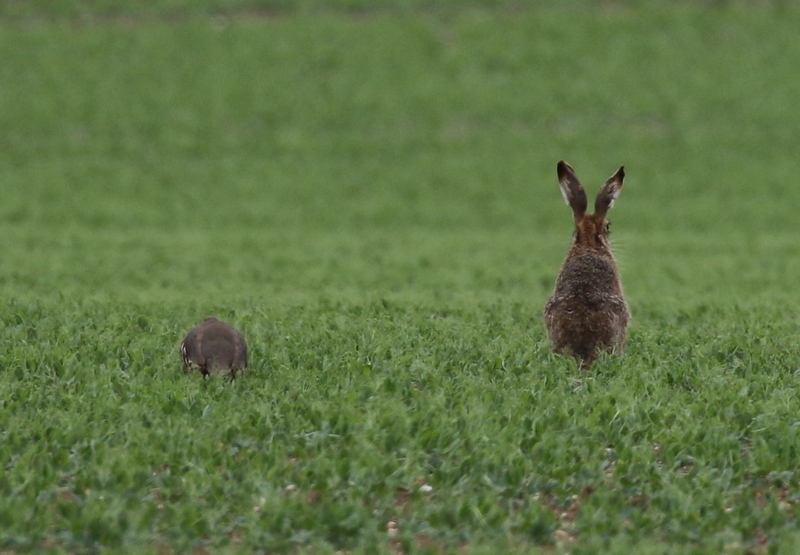 Brown Hare & Red-legged Partridge – admiring the scenery
Brown Hare & Red-legged Partridge – admiring the scenery
It was down to Titchwell next and, after a short break for a hot drink, we walked out onto the reserve. As we made our way along the main path out to the reedbed, we could hear a Cuckoo singing from the bushes. There were several Reed Warblers singing from the reeds and a couple of Cetti’s Warblers shouted at each other from the brambles.
The dried up grazing meadow ‘pool’ was rather devoid of life – it was possibly a bit too windy and exposed out there today. There was more to see on the reedbed pool. A few Tufted Duck and a Common Pochard were diving out in the middle. A Little Grebe swam across and then a Great Crested Grebe flew in from the back and landed closer to us. A Bearded Tit zipped low across the water and dived back into the reeds. A Marsh Harrier circled over the reedbed at the back.
Most of the Brent Geese seem to have departed now, but a couple of smaller groups were still lingering out on the saltmarsh. A very smart Grey Plover, with black face and belly, was lurking on one of the pools.
The water level on the freshmarsh is still rather high – presumably to try to persuade the Avocets to nest within the new high security fence, rather than giving them too many other islands from which to choose. Possibly as a consequence, there are not too many other waders on here at the moment and those that are here can be rather difficult to see.
We did manage to find a Temminck’s Stint looking across from Island Hide, possibly the same bird which was last reported here a couple of days ago. However, it was on the island behind the fence and promptly tucked itself down and went to sleep. Not the best views! There were a few Turnstones trying to shelter from the wind here as well.
There were lots of Common Swifts zooming about low over the water, trying to find insects. These were probably migrants which had stopped off here on their way to try to feed. They were great to watch. There were a few House Martins and Swallows in with them, but later from Parrinder Hide there seemed to be a much larger number of the former.
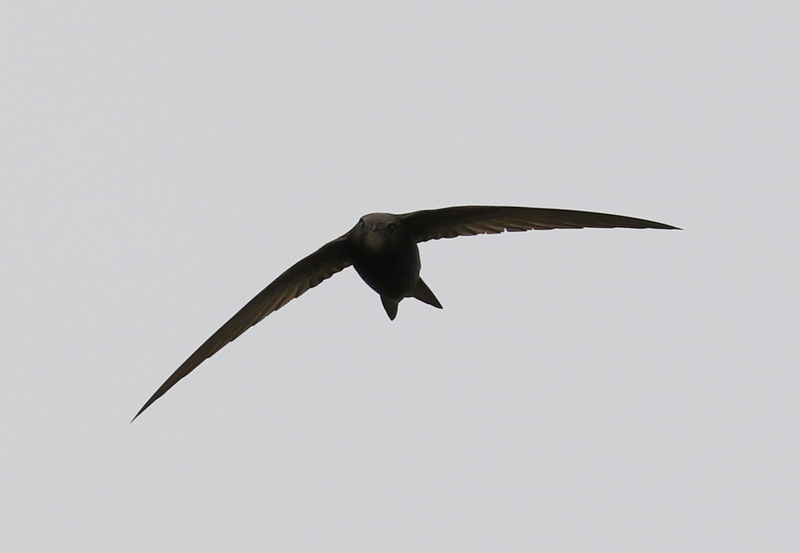
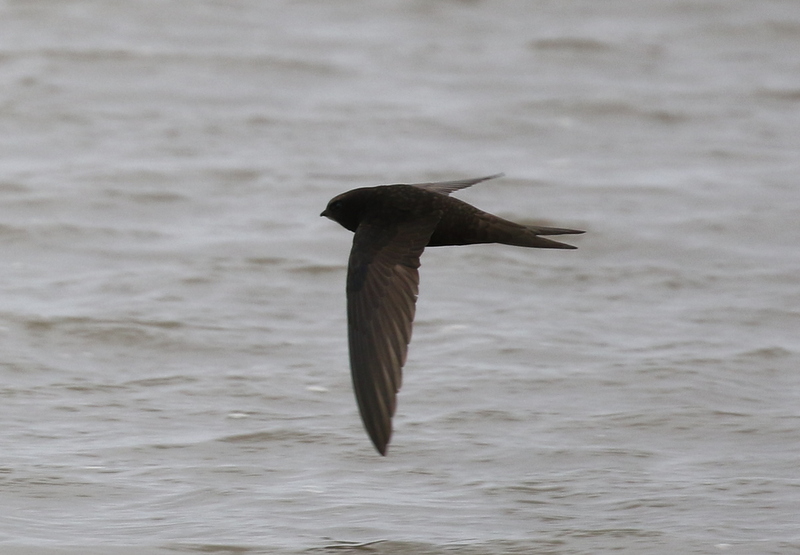
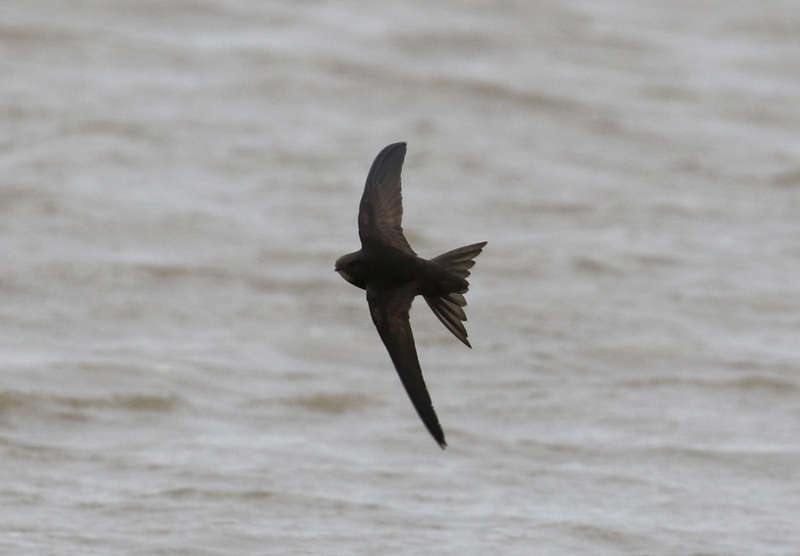 Common Swifts – hawking for insects over the water
Common Swifts – hawking for insects over the water
A Yellow Wagtail flew over, calling, and looked like it might land on one of the islands initially. However, it didn’t stop and carried on over the bank towards the sea. Round at Parrinder Hide, we had better views of a White Wagtail on one of the islands out in front. We could see its pale grey back, much paler than a Pied Wagtail, contrasting more with its black cap.
A noisy gang of Avocets flew round and landed out in the water. They seemed to be having an argument about something and bickered with each other for a while, before chasing round again.
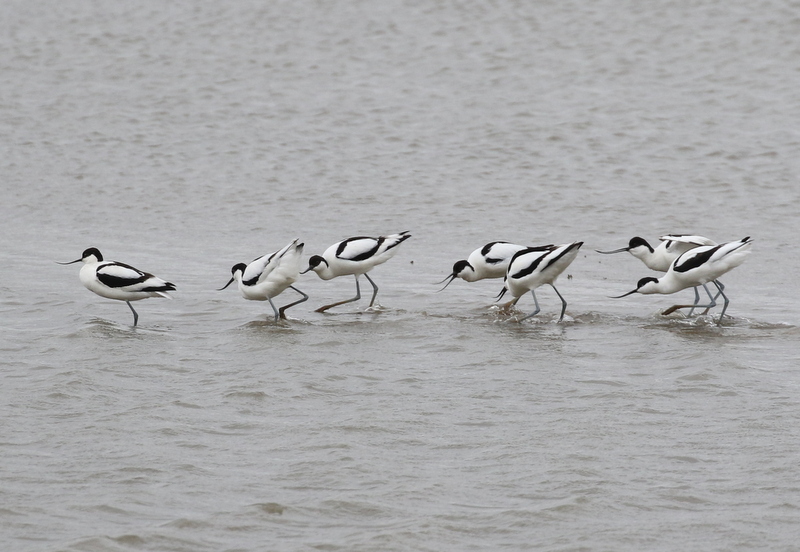
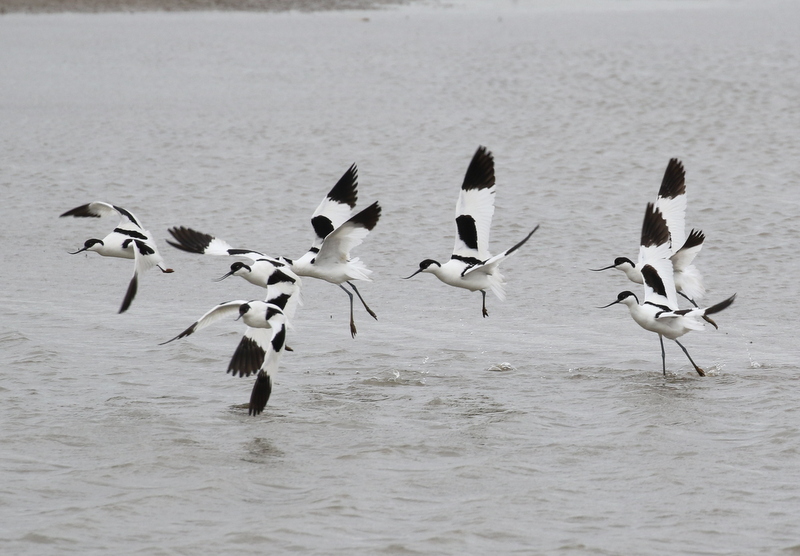 Avocets – this noisy gang seemed to be arguing about something
Avocets – this noisy gang seemed to be arguing about something
There were several Little Ringed Plovers out on the freshmarsh. One was very close to the main path and we had a great look at it – we could see its golden eyering clearly. A single Ringed Plover was on one of the islands in front of Parrinder Hide too. At one point, we even had Ringed Plover and Little Ringed Plover side by side, which was a nice comparison. The former was noticeably bigger, with brighter orange legs and a stumpy black-tipped orange bill, as well as lacking the golden eyering.
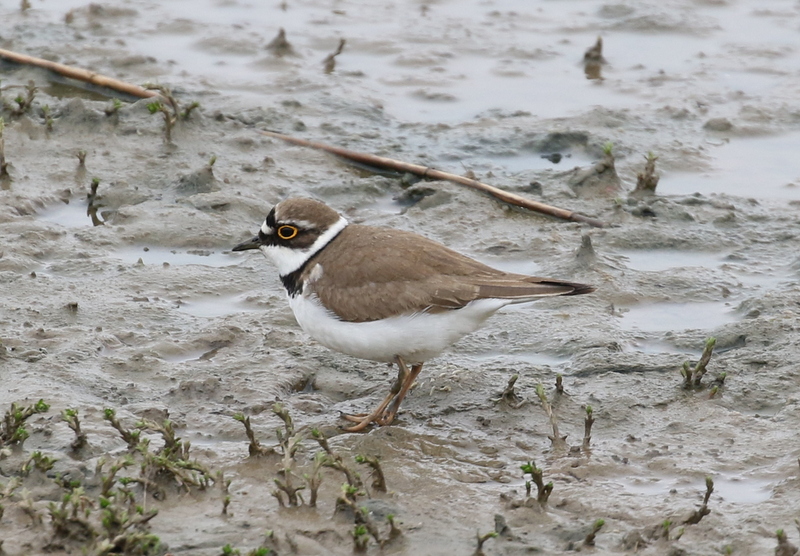 Little Ringed Plover – there were several on the freshmarsh
Little Ringed Plover – there were several on the freshmarsh
Round at Parrinder Hide, the Temminck’s Stint, having obviously woken up, reappeared feeding on the edge of one of the smaller islands, where we could get a much better look at it. There were also several Common Sandpipers round the muddy margins, at least four, and three Dunlin in smart summer plumage, sporting black belly patches.
There are always several pairs of Common Tern on the freshmarsh, but a pair of Little Terns were on here as well today. Through the scope we could see their black-tipped yellow bills and white foreheads.
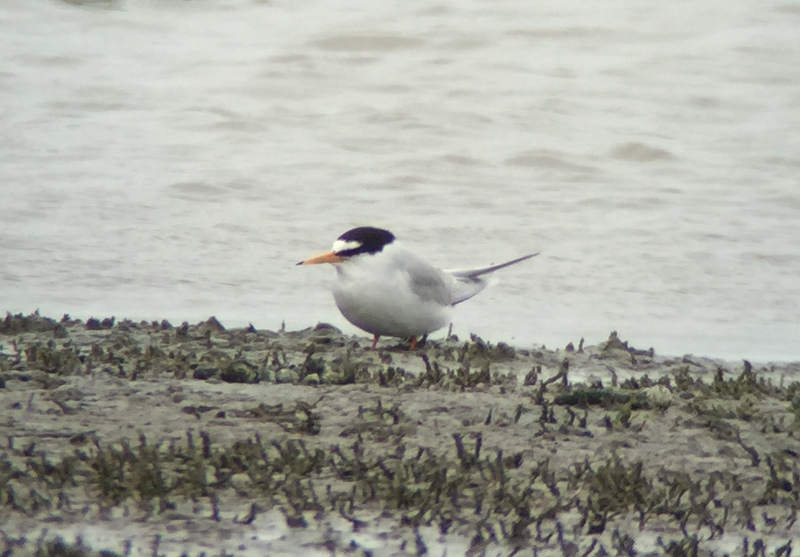 Little Tern – a pair were loafing on one of the islands on the freshmarsh
Little Tern – a pair were loafing on one of the islands on the freshmarsh
There are still a few ducks here. Several pairs of Shoveler and Gadwall will probably stay for the summer, but the couple of pairs of Teal that were still here today will still more likely head north.
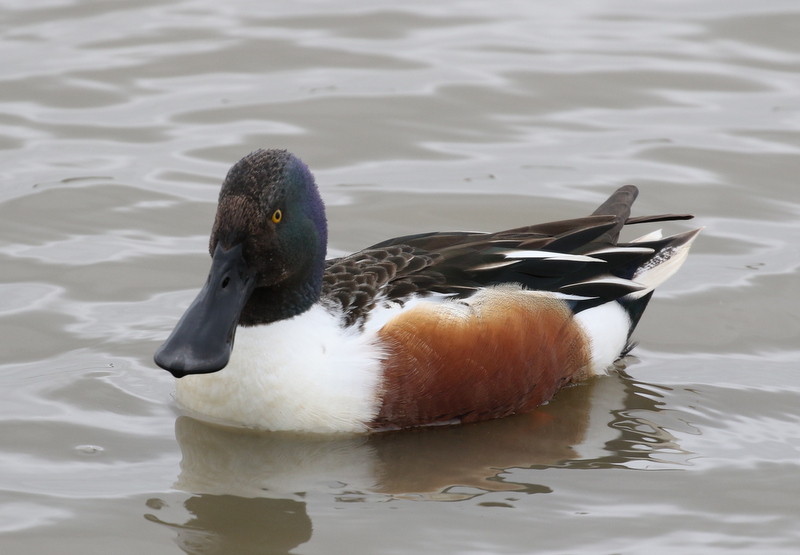 Shoveler – there were several pairs on the freshmarsh
Shoveler – there were several pairs on the freshmarsh
We braved the bracing wind and made our way out towards the sea. The tide was in and the Volunteer Marsh was flooded. There was not much on the Tidal Pools either. Out on the beach there were some large flocks of gulls, mostly Herring Gulls, resting on the sand. Along the shoreline, we could see lots and lots of Sanderling running in and out of the waves, many now in rather dark summer plumage. A single Kittiwake flew past out to sea. Then we decided to get out of the wind and make our way back.
After lunch, we made our way back along the coast to Holkham again. We figured we could get a bit of shelter from the wind in the lee of the pines, so walked west from Lady Anne’s Drive. It was still rather cool here and not so much was singing today. Still, we did hear a couple of Common Whitethroat, one or two Sedge Warblers, several Blackcap and a few Chiffchaff. We managed to see a Goldcrest singing from a holm oak and a few tits – Long-tailed Tits, Great Tits and Coal Tits.
 Marsh Harrier – there were several at Holkham
Marsh Harrier – there were several at Holkham
We stopped to watch a couple of Marsh Harriers circling up from the reeds. When one drifted over the grazing marshes, a large flock of Black-tailed Godwits flew round noisily. As they started to settle back on one of the pools, we could hear a Greenshank calling. When we got the scope on the godwits, we could see two Greenshank out on the mud too. A nearby Pink-footed Goose this side was obviously injured – with what appeared to be a broken wing.
We had a look out from Joe Jordan Hide. There were lots of Cormorants in the trees and a few Little Egrets came and went, but there was no sign of any Spoonbills down on the pool today. We did eventually see a couple of Spoonbills perched up in one of the trees, but they were doing what Spoonbills love to do best – sleeping!
There were more Marsh Harriers coming and going and a Common Buzzards circled in front of the trees. A Kestrel was having a dust bath. A pair of Grey Partridge were feeding on the grass below.
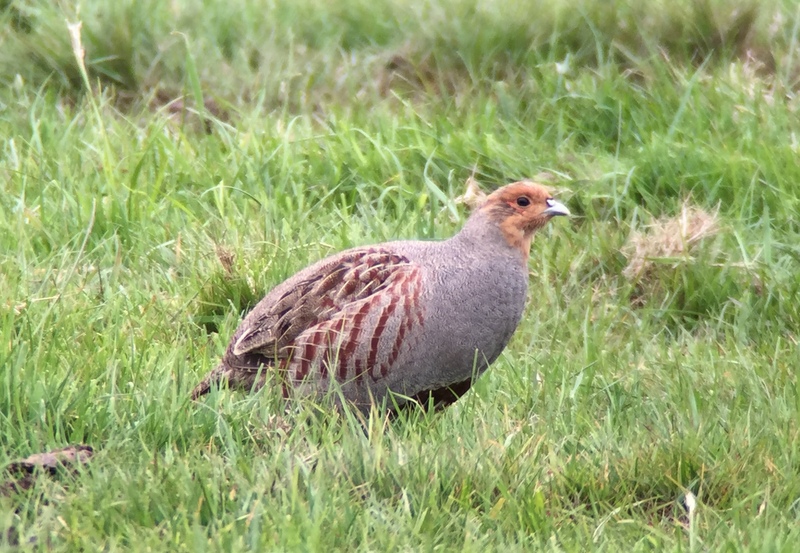 Grey Partridge – a pair were in front of Joe Jordan Hide
Grey Partridge – a pair were in front of Joe Jordan Hide
On our way back, we stopped in at Washington Hide. It appeared to be rush hour for the Spoonbills now! In the space of just a few minutes we had four different birds flying past, in both directions, including an immature bird with dark tips to its primaries. Even at a distance they are instantly recognisable, with their necks held outstretched as they fly, unlike the similarly white Little Egrets, which tuck their necks in.
We had done very well today, despite the cold wind, and it was now time for us to head for home. Thankfully we had all also survived Friday 13th unscathed!
















